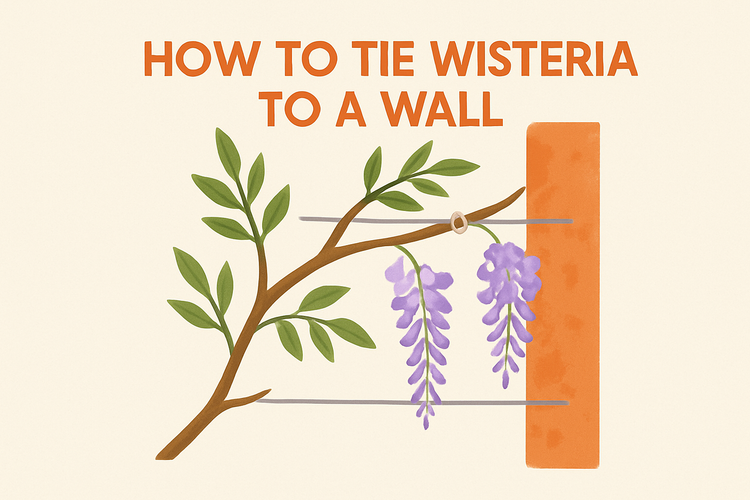How To Tie Wisteria To A Wall

Choosing the Right Wall for Your Wisteria
Picking the right wall is essential before you begin training wisteria. This helps ensure proper sunlight exposure and longevity of the plant.
Wisteria thrives best on south-facing walls that receive plenty of sunlight throughout the day. Sunlight encourages prolific flowering, which is one of the plant's main attractions. It's also important to assess the material and condition of the wall. Ensure the structure is solid enough to support the weight of mature wisteria vines, which can grow quite large and heavy over time. Old brick or concrete walls are generally ideal for long-term stability.
Make sure the wall doesn't have existing cracks or signs of weakness, as the strong growth of wisteria can worsen structural issues. If you're attaching to a masonry wall, consider incorporating masonry connectors and wall ties for added reinforcement. These will anchor your support system securely without damaging the surface unnecessarily.
Installing a Support Structure
Wisteria requires rigorous and sturdy support right from the start. The plant doesn't cling like ivy, so a reliable support structure is key.
The best support systems for wisteria are strong metal or wooden trellises fixed into the wall. Wooden battens, secured horizontally with around 30cm spacing, work well for training new shoots. It’s important to avoid attaching the vine directly to the wall because this can disrupt brickwork or render. Instead, fix galvanised wires or trellises onto the wall using heavy-duty hooks or eye bolts. You may also consider using wall starter profiles for a clean and secure installation of vertical supports when mounting trellising systems.
Support structures should leave a small gap, ideally about 5 cm, between the trellis or wire and the wall to encourage air circulation. This helps prevent fungal diseases and keeps the wall from trapping moisture. As the plant matures, you'll need to ensure the anchors and frames are strong enough to hold the increasing weight. Long-term durability often requires planning in advance, including periodic checks and potential reinforcement.
Attaching the Plant to the Trellis
Once your wall and support structure are in place, it’s time to start training your wisteria. This step is crucial to promote balanced and directed growth.
Start by choosing 2–3 strong stems to act as the main leaders. These should be gently tied to the trellis using soft garden ties or cloth strips, which prevents damage to the plant’s bark. Unlike climbing roses, wisteria does not have tendrils or suckers, so it relies on manual training. As new shoots emerge, twist them gently around the wires or supports, tying them in place to encourage the direction in which you want growth.
Avoid using rigid or thin wire since it can cut into the stems as they grow and expand. Regular maintenance is essential for the first 2–3 years to ensure a strong framework. Using stable hardware like high wind ties and timber connectors can offer increased support where wind exposure might be a concern.
Managing Growth and Pruning Techniques
Pruning serves two main purposes: to restrain vigorous growth and to promote flowering. Without proper cutting back, the plant can become unwieldy and flower poorly.
You'll want to prune wisteria twice a year: once in late July or early August and again in late February. The summer pruning should involve cutting back long new shoots to about five or six leaves, which helps divert energy into flower production rather than extended growth. The winter pruning, on the other hand, should trim those same shoots down to just two or three buds before the growing season begins. This pruning regime keeps the plant tidy and allows light to reach all sections.
Training the growth also involves redirecting stems as they develop. Tie young flexible shoots to your trellis or wire framework in a fan shape to spread them across the wall, ensuring even coverage. If any shoots begin to stray or outgrow their support system, redirect or remove them promptly. A balanced framework not only looks better but also encourages more uniform blooming in the following season.
Maintaining the Structure and Health Over Time
Long-term care is essential for keeping your wisteria and support structure in good condition. Regular inspections help avoid issues that can develop unnoticed.
Every six months, examine both the support structure and wall for any signs of wear or damage. Wood can rot, metal may rust, and even mature vines can shift hardware over time. Ensure that your wall fixings such as trellises or angle brackets remain stable and aren’t pulling away under the pressure of the growing plant. Check for storm damage, especially if you're in a high-wind area, and reinforce where necessary using suitable brackets or ties.
From a plant health perspective, keep an eye out for signs of fungal infections or pests. Good airflow and correct spacing are critical; hence, your initial installation should allow for airflow. Clean up any fallen leaves or pruned stems around the base to prevent the buildup of disease. If necessary, fertilise the soil once a year in spring with a low-nitrogen formula to encourage blooms instead of leafy growth.
Propagate or rejuvenate ageing vines by pruning older wood and encouraging the development of new leaders. With careful, consistent maintenance, your wall-mounted wisteria can thrive for decades, becoming both a structural and aesthetic asset for your home.
